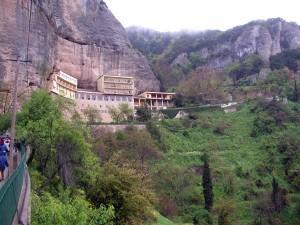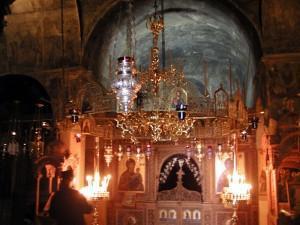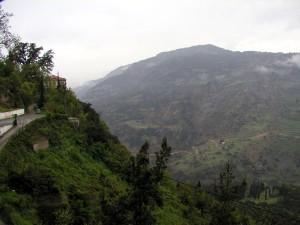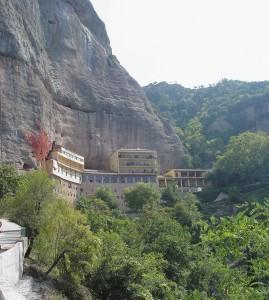Megalo Spileon Monastery
Exactly when the Monastery was instituted is not known; some local traditions tell that it is one of the oldest ones in Greece, and that it was built already in the 4th century A.D.
 The Megalo Spileon (=Big Cave) Monastery lies some 10 kilometers north of Kalavrita, on your way to the Diakofto junction of the Corinth-Patras Highway. Its name is due to the morphology of the place; at a height of 924 meters (2770 feet) on the Aroania Mountains, at the foot of a gigantic 80-meter (240-foot) cliff, a cave-like hollow is formed. Its bow-like entrance leads to a 30-meter deep, 60-meter wide, and 60-meter high cave (90 X 180 X 180 feet) facing west. Outside the cave, clinging to the rock, the monastery building rises to a hight of eight floors. Underneath the rocky formation flows the Vouraikos River in a most beautiful gorge.
Exactly when the Monastery was instituted is not known; some local traditions tell that it is one of the oldest ones in Greece, and that it was founded in 362 A.D. by two brothers from Thessaloniki, who both had a vision and came in search of a holy icon of Our Lady. In 840 A.D., during the horrific iconoclasm events, the monastery was destroyed for the first time. During the Frankish rule (1205-1430), it was  given special privileges and even housed the Metropolitan of Patras. The monastery had to defend itself in 1205 and 1447, when the Franks tried to regain control.
During the first period of Turkish rule, 1466-1684, Megalo Spileon was able to maintain its privileges. In 1639 a major fire destroyed many of the monastery’s precious archives. During the period 1684-1714, under Venetian rule, the monastery was in good financial condition and was able to retain its administrative autonomy.
During the second period of Turkish rule, 1715-1821, the monastery had gained a high level of prestige, which rendered it respectable to everybody, even to the Turkish Administration; with the exception of a couple of incidents, the Turkish authorities protected it against even their Turk-Albanian allies in the Orlof Revolution, where the monks of the monastery took an active part.
In 1821, when Greeks once more revolted against the Turkish rule, the monks followed the Metropolitan in Patras, Palaeon Patron  Germanos, who declared the commencement of the uprising by raising the revolutionary colors in the nearby monastery of Aghia Lavra. During the years that followed, the monks joined in the struggle with the rest of the people and shed their share of blood for the Cause. The Monastery managed to repel three siege efforts and was intact on the day that Greece was declared a free nation. It went on with its spiritual work for more than a century when, in 1934, it was destroyed by a fire of unknown cause.
 In 1943, during the German Occupation, what was left of the monastery, together with the rest of the area, suffered a tremendous and criminal blow by the Nazis. Not only the nearby Kalavrita Town, but the Monastery as well, was looted and burnt down, and the few monks living there were thrown over a precipice and killed.
In the post-war time, the Monastery was rebuilt and continues to play its national, cultural, and spiritual role. It is filled with art and cultural treasures, accessible to the visitor to admire, among which an icon by Apostle Luke, a Byzantine banner bearing the figures of three Emperors, a cross allegedly containing wood from the Holy Cross, remnants of saints in gold or silver reliquaries, local traditional period costumes, etc. Its library contains more than three thousand volumes from the Byzantine and modern eras and a rich collections of manuscripts. Special permission must be sought to have access to these, though.
Clothing suitable for entry to the premises is lent out to the visitors. |
|



